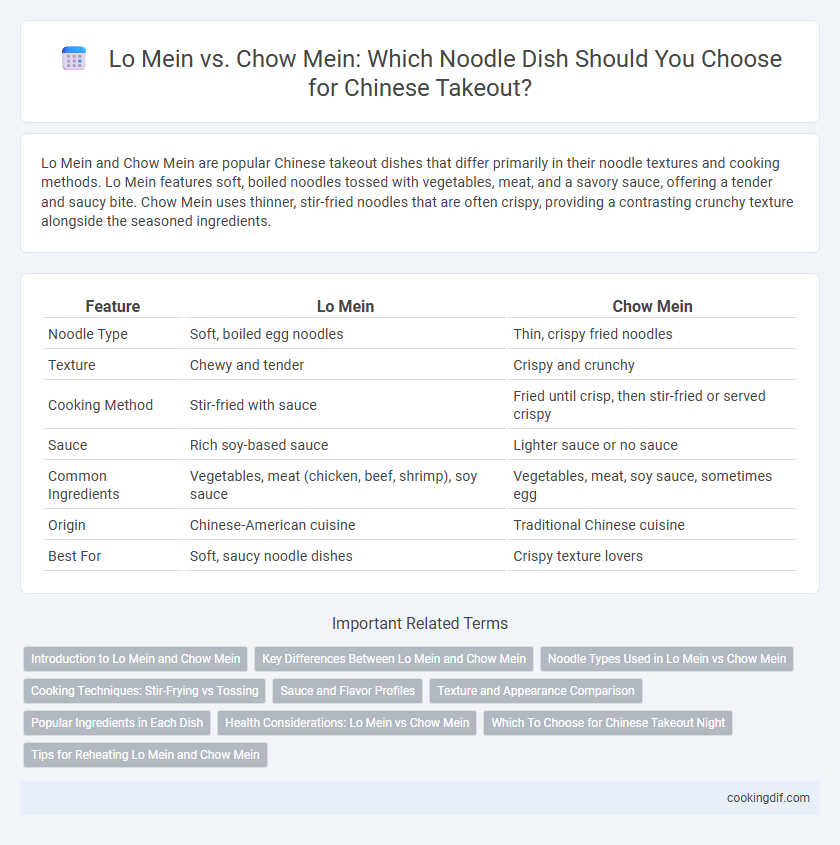Lo Mein and Chow Mein are popular Chinese takeout dishes that differ primarily in their noodle textures and cooking methods. Lo Mein features soft, boiled noodles tossed with vegetables, meat, and a savory sauce, offering a tender and saucy bite. Chow Mein uses thinner, stir-fried noodles that are often crispy, providing a contrasting crunchy texture alongside the seasoned ingredients.
Table of Comparison
| Feature | Lo Mein | Chow Mein |
|---|---|---|
| Noodle Type | Soft, boiled egg noodles | Thin, crispy fried noodles |
| Texture | Chewy and tender | Crispy and crunchy |
| Cooking Method | Stir-fried with sauce | Fried until crisp, then stir-fried or served crispy |
| Sauce | Rich soy-based sauce | Lighter sauce or no sauce |
| Common Ingredients | Vegetables, meat (chicken, beef, shrimp), soy sauce | Vegetables, meat, soy sauce, sometimes egg |
| Origin | Chinese-American cuisine | Traditional Chinese cuisine |
| Best For | Soft, saucy noodle dishes | Crispy texture lovers |
Introduction to Lo Mein and Chow Mein
Lo Mein and Chow Mein are popular Chinese noodle dishes characterized by their distinct preparation methods and textures. Lo Mein features soft, boiled egg noodles tossed with stir-fried vegetables, proteins, and a savory sauce, resulting in a tender and saucy dish. Chow Mein uses crispy, pan-fried egg noodles combined with similar ingredients, offering a contrast in texture with its crunchy, golden exterior.
Key Differences Between Lo Mein and Chow Mein
Lo Mein features soft, boiled noodles that are stir-fried briefly with vegetables, meats, and sauce, resulting in a tender texture that absorbs flavors well. Chow Mein uses thin, crispy noodles that are either pan-fried or deep-fried, creating a crunchy texture distinct from the softness of Lo Mein. The key difference lies in noodle texture and cooking method: Lo Mein is saucy and soft, while Chow Mein is crispier and often less saucy.
Noodle Types Used in Lo Mein vs Chow Mein
Lo Mein features soft, boiled egg noodles that are thick and chewy, absorbing sauces for a tender texture. Chow Mein uses thin, crispy fried noodles with a crunchy bite, offering contrast to stir-fried vegetables and proteins. The distinct noodle types define the mouthfeel and overall eating experience of each dish in Chinese takeout.
Cooking Techniques: Stir-Frying vs Tossing
Lo Mein is prepared by tossing boiled noodles with stir-fried vegetables and protein, allowing the sauce to coat each ingredient evenly without further high-heat cooking. Chow Mein involves stir-frying raw or par-cooked noodles at high heat in a wok, creating a slightly crispy texture and smoky flavor. The distinct cooking techniques result in Lo Mein's soft, saucy noodles contrasting Chow Mein's firm, textured bite favored in Chinese takeout.
Sauce and Flavor Profiles
Lo Mein features soft, chewy noodles tossed in a savory, slightly sweet soy-based sauce that absorbs flavors deeply, offering a rich, umami taste. Chow Mein consists of crispy or pan-fried noodles with a lighter, less saucy coating, highlighting a more textured bite and a subtle, savory flavor profile. The sauce in Lo Mein is typically thicker and more concentrated, while Chow Mein's sauce is thinner, allowing the noodles' crispiness to shine through.
Texture and Appearance Comparison
Lo Mein features soft, tender noodles that absorb sauce for a moist texture, while Chow Mein offers a crispier bite due to its pan-fried or stir-fried preparation. Lo Mein noodles appear thicker and more pliable with a glossy finish, whereas Chow Mein noodles are thinner, often slightly browned and crispy. The contrast in cooking methods creates distinctive textures that influence the overall appearance and mouthfeel of these popular Chinese takeout dishes.
Popular Ingredients in Each Dish
Lo Mein typically features soft, chewy egg noodles tossed with a mix of soy sauce, garlic, ginger, and popular ingredients like sliced chicken, shrimp, bok choy, and carrots. Chow Mein is characterized by its crispy or pan-fried noodles, combined with a savory sauce and a variety of vegetables such as bean sprouts, cabbage, and green onions, often accompanied by chicken or beef. Both dishes incorporate key proteins and vegetables, but Lo Mein emphasizes a saucier, softer noodle experience while Chow Mein highlights a contrast of textures with crispiness and fresh vegetables.
Health Considerations: Lo Mein vs Chow Mein
Lo Mein noodles are typically boiled and tossed with sauce, resulting in a softer texture and often higher sodium content due to the heavy use of soy sauce and oil. Chow Mein noodles are stir-fried, sometimes allowing excess oil to drain off, which can reduce overall fat content, but crispy versions may involve deep-frying, increasing calorie and fat intake. Choosing steamed or lightly stir-fried chow mein over heavily sauced lo mein helps lower calorie consumption and sodium levels, supporting healthier Chinese takeout options.
Which To Choose for Chinese Takeout Night
Lo Mein offers soft, chewy noodles tossed with savory sauces and a mix of vegetables and proteins, making it ideal for those craving a comforting, saucy dish. Chow Mein features crispy, stir-fried noodles with a slightly crunchy texture, perfect for customers who prefer a crisp bite with their Chinese takeout. Choosing between Lo Mein and Chow Mein depends on whether you want tender noodles soaked in flavor or a crunchy, stir-fried experience for your Chinese takeout night.
Tips for Reheating Lo Mein and Chow Mein
Lo Mein and Chow Mein require different reheating techniques to preserve their distinct textures; Lo Mein noodles benefit from steaming or microwaving with a damp paper towel to maintain softness, while Chow Mein's crispy noodles are best reheated in a hot skillet to restore their crunch. Avoid overcooking Lo Mein to prevent sogginess, and reheat Chow Mein quickly on high heat to keep them from becoming greasy. Using a non-stick pan ensures even heat distribution, enhancing the quality of both Chinese takeout dishes.
Lo Mein vs Chow Mein for Chinese takeout Infographic

 cookingdif.com
cookingdif.com